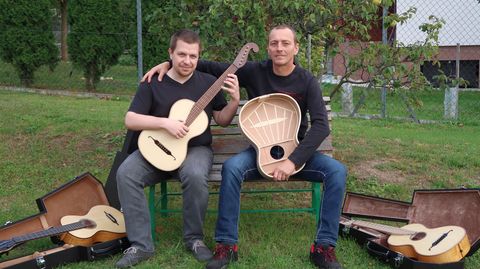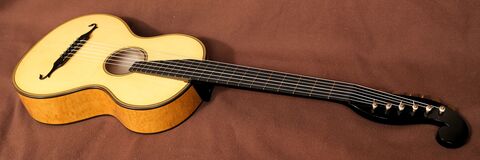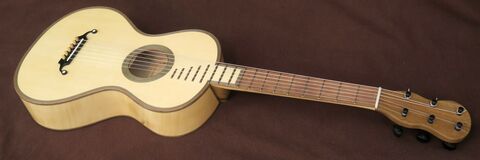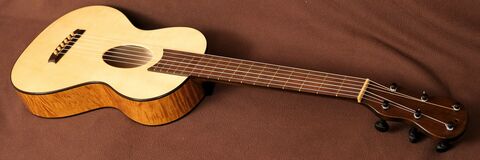About us
Luthier Martin Okenica ['mʌrtin 'ɔkeˌɲitsɑ] and guitarist Marek Cupák ['mʌrek 'tsupɑ:k] have been friends for many years now. They met back when Marek, besides his university studies, taught classical guitar at local music elementary school in their hometown of Holíč in Slovakia, and one of Martin's sons began to attend the classes. By that time, Martin, being himself a self-taught hobby guitarist, already had some luthier experience, which was primarily focused on building electric guitars for his own needs and passion.
First suggestions in the direction classical and period guitarmaking came shortly after. Ever since, their cooperation was beneficial to both Martin's guitarmaking and Marek's playing, as this constant, bilateral feedback encouraged professional growth and brought further suggestions, ideas and improvements to both of them. Martin's experience and Marek's support cumulated to a point, which turned the guitarmaking into full-time occupation, practiced in a completely equipped, full-featured workshop, supplied by an own, carefully kept store of quality woods and material, backed-up by a considerable knowledge-base, including a library of professional literature and building plans.
From the legal point of view there is a small two-man private limited liability company established for above mentioned purposes, named Hexachord Studios s.r.o., which covers activities of both participants.
Our philosophy
A well built and properly looked-after instrument will last far longer than a single human lifetime. Therefore, we see our guitars as our investments. Investments into knowledge, skills and craftsmanship, which we want to make as valuable and as durable as possible, and simultaneously keep them accessible and their values transferable to our customers by offering a fair price.
We do mind our environment and we do see the astonishing value in resources it provides. Hence, we very much prefer domestic wood species to exotic ones, which often are nowadays considered threatened or vulnerable in the first place, and also pose extra burden to our planet by being transported over huge distances. Sure we can use them, yet there is enough domestic, European species providing excellent acoustic performance, highly aesthetically pleasing look and are very practical to work with. Spruce, maple, walnut and pear are the most common, but only a few examples to name. Furthermore, instruments made this way do not require any CITES certification and can be shipped all over the world without any restrictions.
Our own-developed and own-built, customizable, plastic-free guitar cases let us underline this attitude.
We also avoid using synthetic lacquers - polyurethane, nitrocellulose and alike - being artificial and often thick in layer, we think they diminish acoustical capacities of the instrument by dampening wood vibrations to an unnecessary extent. Natural oil varnishes and eventually shellac are used instead. Read more in tips on instrument care section, which represents another part of our approach.
There are no "student models" - every guitar is built with the best intention in mind and none should be inferior to any other. We support students by offering price reductions and/or split payments. More on these topics in the pricing section.
Last but not least, a phrase Martin uses to say: "What's done hastily, can't be any good."
Instruments
Early romantic
All the initial inspiration to build period guitar replicas came from the work of French luthier François René LaCôte (cca 1785 - 1868). The most essential element adopted is definitely the top bracing pattern and construction of back and sides, which is either full-massive or consists of reinforced spruce layer on the inside and outer decorative veneering.
Later on we studied instruments made by Johann Georg Stauffer (1778 - 1853), Louis Panormo (1784 - 1862), Étienne Laprévotte (? - 1856) and other master builders of the time. Our Stauffer models feature "floating fingerboard" mechanism, easing string action adjustment without putting the strings down or even out of tune. The six-string version can be fitted with a period Stauffer tuners replica of our own design and production. The Panormo model offers tuners custom-made to our own specification. The Laprévotte model is a class of its own, as the guitar features a violin-like bracing pattern and construction type.
Late romantic
Earlier works of Hermann Hauser I. (1882 - 1952), like the 1920 model, came to our portfolio purely through customer request. We've looked up some sources and contacted our colleagues in order to get as much documentation as possible and there it was, a rather unusual instrument is now available. It offers features from both early romantic and modern classical guitar world. The Stauffer-like Viennese neck and floating fingerboard are still there, whereas the top bracing pattern is already built in Spanish way - fan strutting, although narrowly spread and without the V-braces, which H. Hauser added to his design somewhat later on. Another interesting part is the bridge, which lifts all the string tension off the top and puts it into a far stiffer region of end pin. Hence, string tension itself stresses the top in nearly no way and allows it to be of quite thin and of delicate bracing.
Modern classical
Crucial elements of our modern classical designs are inherited from instruments of Hermann Hauser I. (1882 - 1952) and José Luis Romanillos (1932*). The body shape and its internals, mostly the strutting patterns and top's thickness distribution, are reproduced accurately. Functional modifications - multistring variations or floating fingerboard - do come from us, as optionals. Aesthetics, like inlays, head ornamentation and tuner plate shapes, etc., are modified to our taste. Decorative back and sides veneering is possible, although the original instruments were usually not built this way.
Accessories
Sound samples
References
"...they are both excellent instruments, built with great skill, sonorous and resounding, extremely comfortable to play."
"An absolutely magical guitar! Arrived in perfect condition from Slovakia, carefully packed. Marek was exceptionally helpful in ensuring its safe arrival. I highly recommend Okenica if you are ready for a special instrument..."
"...His historical instruments do have an interesting and full natural sound color, a comfortable fingerboard and many shades of sound timbre available. His Stauffer model, which I currently play, handles with clarity and balance all the intensive dynamic playing or, on the contrary, very subtle, colorful nuances that music and my interpretive demands require. I am very glad that we finally have an excellent master of historical instruments in Slovakia, who will not be lost on the international stage either. I highly recommend Martin's instruments."
"I'm very satisfied so far, tried it a bit today. Exactly the sound I've been looking for and it's so beautiful to look at. It probably takes some time to get used to the tuning pegs as I think it's a little tricky to tune so far but I will get a hand on that to in time. And the case is great! You have done a great job on both guitar and case. Thank you so very much..."
"...The action is very comfortable in all positions and in the higher positions there is no fret buzz. The frets themselves are extremely well finished and glissandi and slurs cause no discomfort to my fingers or unpleasant noises from the strings. The fret place is excellent and the harmonics are true and easily played. There is no (as far as I can hear) deviation in the scale when I play with Kevin on the harp or a friend with her oboe..."
Read full messages in dedicated section...
General information
Finished instruments available right away are listed here. A selection of instruments not available any more is listed in our archive.
If you'd like to have your instrument built to your specification, please have a look at recommended materials and customization options.
Building an instrument usually takes from 3 to 6 months. Depending on our current capacities, there may be some delay.
There always is a trial period of at least 14 days, within which the instrument can be returned at the customer's expense. Full refund will be issued as soon as the instrument reaches us in the same condition it left. We didn't have any returns yet.
Instruments are stored and offered in hard cases only. If you want to have the instrument delivered by a postal service, it is necessary to choose one. Cases for period guitars are built customized to fit each instrument perfectly.
All audio samples listed on these pages are not processed using any equalization.
Manufacturing process will be upon request documented by high-resolution photography.
Pricing
Following prices are valid for the year 2024, listed in EUR without VAT.
Prices range from € 4085 to € 6085, an instrument in its most usual configuration, case including, does cost around € 4410. There are several options of having your instrument customized. You can choose a model, number of strings, nut width, tuners, finishing, straps for the case, string sets... and there usually are a few materials to choose from. Many customizations come for free. Payment split into several installments and / or price reductions for students are possible.
Please feel free to check all the possibilities and have a look at our pricing in detail.
Tips on instrument care
What to do
Put the instrument into its case when it isn't being played and don't forget to securely close it.
Store in an environment of relative air humidity varying within a narrow interval of about 40% to 45%.
You can tune up to A1 = 443 Hz, but preferably start with normal-tension string set. We tune our modern instruments to nowadays standard tuning of A1 = 440 Hz. They are usually strung using normal-tensions string sets.
Our period instruments do have a bit shorter scale length, hence we recommend to tune them to A1 = 430 Hz or 432 Hz. You can use modern nylon / carbon / nylgut strings without any doubts.
If there are friction tuning pegs or bridge pins on your instrument, try to keep their order when you change strings. They will just fit. Otherwise, they might get slightly misaligned in height and it can be harder to find their initial ordering.
What rather not to do
String up steel strings. Classical or period guitars are not built to bear their tension. Use gut & silk, nylgut, nylon, carbon or similar strings designed particularly for classical guitars.
Lean the instrument on a heater or close proximity to it. Or let the instrument freeze in car's trunk overnight and then unpacking it inside of heated household without any acclimatization period in its case closed. Avoid sudden changes of temperature.
Put an oversoaked humidifier inside the instrument - dripping water will very probably do lots of damage. If you need to use humidifier, always squeeze excess water out of it and wipe all drops off its surface. Avoid sudden changes of humidity.
Spill any chemicals over the finish or try to clean the instrument using anything other than soft, lint-free cotton cloth, slightly moist with pure water only.
Special word on shellac finishing
Shellac is a natural product, whose quality depends on several factors. A subtle layer of shellac contributes to overall sound quality, because in contrast to synthetic lacquers, its application in the slightest thickness is possible, so that the oscillations of wood remain under minimal attenuation, whereby the soft and warm nature of the tone itself is not diminished. It is not resistant to:
Mechanical damage - nail scratches, zip fasteners and rough buttons on clothing, note-stand edges, etc.
Some player's aggressive sweat, under which it can get rough and loose its gloss. Prolonged exposure will almost certainly do some damage, but on the other hand, there are players who generally do not experience such problems.
Formation of micro-cracks, caused by wood's expansion when exposed to significant temperature, but mostly humidity variations.
Alcohol, its solvent.
Above mentioned pros and cons of shellac finishing led us to favor oil varnishes instead, for the whole instrument. They are far more durable and do also provide similarly pleasing acoustics and aesthetics. Shellac finish is still being offered and certainly will be, an instrument finished completely in shellac is well doable, but we very much recommend to use it on top only, if at all.
Contact
Feel free to write in English, German, Czech or Slovak. In other cases we will have to use automated translation, which is usable, but tends to be less precise.
Your messages will most probably be replied by Marek, who usually manages our international correspondence.

Workshop
- Martin Okenica
- Pod sýpkou 2981/14
- 908 51 Holíč
- Slovak Republic
Impressum
- Hexachord Studios s. r. o.
- Jána Ondruša 2790/13K
- 900 31 Stupava
- Slovak Republic
- ID: 52461815
- Tax ID: 2121032199
- VAT number: SK2121032199
- Registered in the Commercial Register of the District Court Bratislava I, section Sro, file no. 138191 / B











